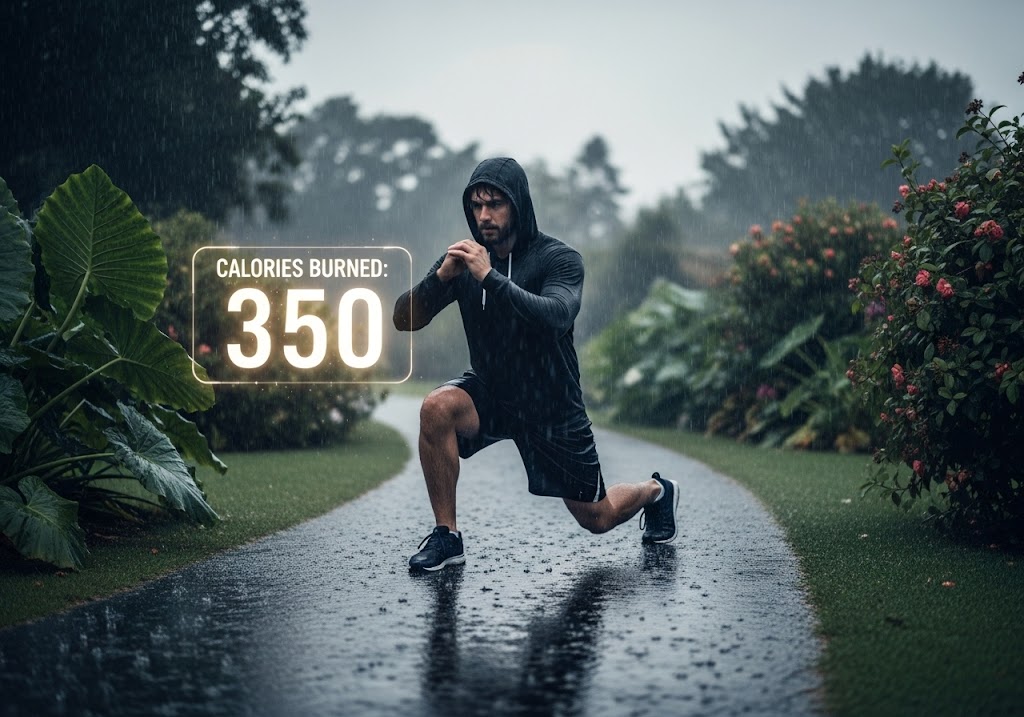Calories burned in lunges typically range from 5-7 calories per minute, with approximately 0.3 calories burned per individual lunge for the average person.
Understanding calories burned in lunges helps you plan effective workouts and reach your fitness goals faster. Lunges are powerful compound exercises that work multiple muscle groups simultaneously, making them excellent for burning calories while building strength. Whether you’re doing bodyweight lunges or adding weights, knowing the exact calorie burn helps optimize your training routine.
Many people wonder exactly how many calories burned in lunges during their workouts. The answer depends on several factors including your body weight, exercise intensity, lunge variations, and workout duration. A typical person burns approximately 5-7 calories per minute performing lunges, which translates to about 0.3 calories per individual lunge movement.
Table of Contents
Calories Burned in Lunges – How many calories do lunges burn?
Understanding the exact calories burned in lunges provides essential data for planning effective weight loss and fitness routines. Research shows that calories burned in lunges varies significantly based on individual factors, exercise intensity, and movement variations, making it crucial to understand these variables for optimal results.
The science behind calories burned in lunges involves measuring your body’s energy expenditure during muscle contractions. When you perform lunges, large muscle groups including quadriceps, hamstrings, glutes, and core muscles work together, requiring substantial energy to complete each repetition. This multi-muscle engagement is what makes lunges such effective calorie-burning exercises.
| Intensity Level | Calories Burned Per Minute | Calories Per Lunge | 10-Minute Session |
|---|---|---|---|
| Light Intensity | 4-5 calories | 0.2-0.25 calories | 40-50 calories |
| Moderate Intensity | 5-7 calories | 0.3-0.35 calories | 50-70 calories |
| High Intensity | 7-9 calories | 0.4-0.45 calories | 70-90 calories |
| Very High Intensity | 9-12 calories | 0.5-0.6 calories | 90-120 calories |
Several research studies have measured calories burned in lunges using metabolic testing equipment. The average person burns approximately 5.7 calories per minute during moderate-intensity lunging exercises. This rate can increase to 7+ calories per minute with high-intensity variations like jumping lunges or weighted lunges, making them excellent for fat burning workouts.
Learn how to start calisthenics.

Lunge Calorie Burn by Repetition Count
Regular Lunges Calorie Burn
Understanding calorie expenditure for different lunge repetition counts helps plan effective workout routines and track progress accurately. These calculations provide practical guidance for anyone wondering about specific rep counts and their metabolic impact. Body weight and intensity significantly influence total calorie burn during lunge exercises.
Regular Lunges Calorie Burn Table
| Lunge Count | Light Weight (50-60kg) | Medium Weight (60-80kg) | Heavy Weight (80kg+) | Duration |
|---|---|---|---|---|
| 10 lunges | 2-3 calories | 3-4 calories | 4-5 calories | 30-45 seconds |
| 20 lunges | 4-6 calories | 6-8 calories | 8-10 calories | 1-1.5 minutes |
| 30 lunges | 6-9 calories | 9-12 calories | 12-15 calories | 1.5-2 minutes |
| 40 lunges | 8-12 calories | 12-16 calories | 16-20 calories | 2-2.5 minutes |
| 50 lunges | 10-15 calories | 15-20 calories | 20-25 calories | 2.5-3 minutes |
| 60 lunges | 12-18 calories | 18-24 calories | 24-30 calories | 3-3.5 minutes |
| 70 lunges | 14-21 calories | 21-28 calories | 28-35 calories | 3.5-4 minutes |
| 80 lunges | 16-24 calories | 24-32 calories | 32-40 calories | 4-4.5 minutes |
| 90 lunges | 18-27 calories | 27-36 calories | 36-45 calories | 4.5-5 minutes |
| 100 lunges | 20-30 calories | 30-40 calories | 40-50 calories | 5-6 minutes |
Calories Burned in 10 Regular Lunges
Ten lunges provide a quick lower body activation that takes approximately 30-45 seconds to complete at moderate pace. This minimal count serves as an excellent warm-up or movement break during sedentary activities. Perfect for beginners learning proper lunge mechanics or as active recovery between more intense exercise sets.
Calories Burned in 20 Regular Lunges
Twenty lunges create a solid mini-workout lasting about one minute, beginning to elevate heart rate while building leg strength. This count provides meaningful muscle activation without excessive fatigue, making it ideal for daily movement habits. Excellent stepping stone for those progressing from basic movement to structured exercise routines.
Calories Burned in 30 Regular Lunges
Thirty lunges represent a moderate training volume requiring 1.5-2 minutes of sustained effort and focus on proper form. This count challenges muscular endurance while providing significant calorie burn and strength building benefits. Ideal for intermediate exercisers looking to build consistency and establish regular movement patterns in their daily routine.
Calories Burned in 40 Regular Lunges
Forty lunges create a substantial lower body challenge lasting 2-2.5 minutes, demanding sustained muscle contraction and cardiovascular effort. This volume builds exceptional unilateral leg strength while improving balance and coordination through extended practice. Perfect for those seeking noticeable fitness improvements and measurable strength development through consistent training.
Calories Burned in 50 Regular Lunges
Fifty lunges constitute a significant training milestone requiring 2.5-3 minutes of dedicated effort and mental focus. This count provides substantial calorie burn while building functional strength and muscular endurance throughout the lower body. Excellent benchmark for intermediate to advanced exercisers committed to achieving meaningful fitness results through consistent practice.
Calories Burned in 60 Regular Lunges
Sixty lunges create an extended training session lasting 3-3.5 minutes, challenging both physical and mental endurance significantly. This volume provides excellent calorie burn while building exceptional unilateral strength and movement quality. Ideal for advanced beginners and intermediate exercisers ready to push beyond comfort zones and achieve substantial fitness improvements.
Calories Burned in 70 Regular Lunges
Seventy lunges represent serious training commitment requiring 3.5-4 minutes of sustained effort and unwavering focus. This count challenges cardiovascular fitness while building substantial leg strength and muscular endurance throughout multiple muscle groups. Perfect for experienced exercisers seeking advanced challenges and measurable improvements in both strength and conditioning levels.
Calories Burned in 80 Regular Lunges
Eighty lunges create an advanced training challenge lasting 4-4.5 minutes, demanding exceptional muscular endurance and mental toughness. This volume provides significant calorie burn while building functional strength essential for athletic performance and daily activities. Excellent for competitive athletes and fitness enthusiasts committed to pushing physical boundaries consistently.
Calories Burned in 90 Regular Lunges
Ninety lunges constitute an elite-level training volume requiring 4.5-5 minutes of sustained maximum effort and concentration. This count challenges every aspect of fitness including strength, endurance, balance, and mental resilience simultaneously. Ideal for advanced athletes and dedicated fitness enthusiasts seeking to test limits and achieve exceptional conditioning results.
Calories Burned in 100 Regular Lunges
One hundred lunges represent the ultimate bodyweight lower body challenge, requiring 5-6 minutes of sustained effort and exceptional mental fortitude. This milestone volume provides maximum calorie burn while building extraordinary functional strength and muscular endurance. Perfect for elite athletes and fitness enthusiasts committed to achieving peak physical conditioning and personal excellence.
Factors Affecting Calories Burned in Lunges
Understanding what influences calories burned in lunges helps you optimize your workouts for maximum energy expenditure. These key factors determine how efficiently your body burns calories during lunge exercises and other physical activities.
Multiple variables influence how many calories burned in lunges you’ll experience during each workout session:
- Body Weight – Heavier individuals burn more calories per lunge because moving greater body mass requires more energy expenditure
- Exercise Intensity – Faster pace, deeper lunges, and explosive movements significantly increase calorie burn rates per minute
- Lunge Variations – Walking lunges, jumping lunges, and weighted versions burn more calories than basic stationary lunges
- Muscle Mass – People with more lean muscle tissue burn calories more efficiently even during rest periods between sets
- Form Quality – Proper technique with full range of motion engages more muscles and burns more calories per repetition
- Workout Duration – Longer lunge sessions naturally burn more total calories, though intensity may decrease over time
- Rest Periods – Shorter rest between sets maintains elevated heart rate and increases overall calorie burn during workouts
- Environmental Factors – Hot or cold temperatures can slightly increase energy expenditure during exercise sessions
Find out the exact energy expenditure with how many calories do bicycle crunches burn

Hoe Many Calories Do Body Weight in Lunges Burn?
Body weight significantly impacts calories burned in lunges because heavier individuals require more energy to move their mass through each repetition. This section provides specific calorie estimates based on different weight ranges for accurate workout planning.
Different body weights affect calories burned in lunges substantially. Here’s how your weight influences calorie expenditure:
| Body Weight | Calories Per Minute | Calories Per Lunge | 100 Lunges Total |
|---|---|---|---|
| 54 kg | 4.2 calories | 0.21 calories | 21 calories |
| 64 kg | 4.9 calories | 0.24 calories | 24 calories |
| 73 kg | 5.6 calories | 0.28 calories | 28 calories |
| 82 kg | 6.3 calories | 0.31 calories | 31 calories |
| 91 kg | 7.0 calories | 0.35 calories | 35 calories |
| 100 kg | 7.7 calories | 0.38 calories | 38 calories |
These calculations use standard MET values for moderate-intensity calisthenics exercises. Remember that calories burned in lunges can vary based on individual metabolism, fitness level, and exercise technique quality.
Start your fitness journey properly by learning about warm up exercises for beginners before performing lunge workouts.
Lunge Variations and Calorie Burn
Lunge variations provide exceptional lower body strengthening while burning significant calories through dynamic movement patterns. These unilateral exercises challenge balance, coordination, and muscular endurance while targeting glutes, quadriceps, and hamstrings. Different variations offer scalable difficulty levels from beginner-friendly stationary lunges to advanced plyometric and multi-directional challenges.
Lunge Variations Overview
| Sr.No. | Exercise | Calories/Hour | Difficulty | Primary Muscles | Equipment | Special Focus |
|---|---|---|---|---|---|---|
| 1 | Basic Forward Lunge | 300-450 | Beginner | Quads, Glutes | None | Foundation movement |
| 2 | Reverse Lunge | 320-480 | Beginner-Intermediate | Glutes, Hamstrings | None | Hip-dominant pattern |
| 3 | Walking Lunges | 400-600 | Intermediate | Full lower body | None | Dynamic movement |
| 4 | Jump Lunges | 500-750 | Intermediate-Advanced | Power, Full body | None | Plyometric training |
| 5 | Lateral Lunges | 350-520 | Intermediate | Inner thighs, Glutes | None | Lateral movement |
| 6 | Curtsy Lunges | 330-500 | Intermediate | Glutes, Hip stability | None | Multi-planar motion |
| 7 | Bulgarian Split Squats | 400-600 | Intermediate-Advanced | Unilateral strength | Bench/Chair | Single-leg focus |
| 8 | Clock Lunges | 450-650 | Advanced | Full body coordination | None | Multi-directional |
| 9 | Weighted Lunges | 500-750 | Intermediate-Advanced | Increased resistance | Dumbbells/Kettlebells | Progressive overload |
| 10 | Elevated Reverse Lunges | 420-630 | Advanced | Extended range | Platform/Step | Enhanced depth |
Detailed Lunge Variation Instructions
1. Basic Forward Lunge
The basic forward lunge serves as the foundation for all lunge variations, teaching proper knee tracking, hip stability, and unilateral strength development. This fundamental movement builds functional strength while improving balance and coordination through single-leg training. Mastering the forward lunge is essential before progressing to more complex variations that require greater stability, power, or multi-directional movement patterns.
How to Do Basic Forward Lunges?
- Step forward with one leg into lunge position, lowering until both knees form 90-degree angles
- Keep front knee directly over ankle and back knee hovering just above ground throughout movement
- Push through front heel to return to starting position, alternating legs or completing all reps on one side
2. Reverse Lunge
Reverse lunges emphasize hip-dominant movement patterns while placing less stress on the knees compared to forward lunges. This variation builds exceptional glute and hamstring strength while improving posterior chain activation and hip mobility. The backward stepping motion makes reverse lunges easier to control and safer for those with knee concerns or balance issues.
How to Do Reverse Lunges?
- Step backward with one leg, lowering into lunge position while keeping most weight on front leg
- Descend until both knees reach 90-degree angles, maintaining upright torso throughout movement
- Push through front heel to return to starting position, focusing on glute activation during ascent
3. Walking Lunges
Walking lunges combine the benefits of stationary lunges with dynamic forward movement, creating continuous motion that elevates heart rate and burns more calories. This variation builds functional strength while improving coordination, balance, and cardiovascular endurance. The continuous movement pattern makes walking lunges excellent for conditioning workouts and developing real-world movement skills.
How to Do Walking Lunges?
- Step forward into lunge position, then push off back foot to bring it forward into next lunge
- Continue alternating legs in walking pattern, maintaining proper lunge form throughout movement
- Focus on controlled transitions and consistent lunge depth while moving forward in straight line
4. Jump Lunges
Jump lunges add explosive plyometric training to the lunge movement, dramatically increasing calorie burn while developing power, speed, and athletic performance. This high-intensity variation builds fast-twitch muscle fibers while improving cardiovascular fitness through intense muscular demands. The explosive nature makes jump lunges excellent for athletes and those seeking maximum calorie burn in minimal time.
How to Do Jump Lunges?
- Start in lunge position, then explosively jump up while switching leg positions in mid-air
- Land softly in opposite lunge position with control, immediately preparing for next explosive jump
- Maintain rapid alternating pattern while focusing on proper landing mechanics and form throughout
5. Lateral Lunges
Lateral lunges develop strength and mobility in the frontal plane, targeting inner thighs, outer glutes, and improving hip flexibility. This variation addresses lateral movement patterns often neglected in traditional training while building functional strength for sports and daily activities. The side-to-side movement challenges stability and coordination while providing excellent adductor and abductor strengthening.
How to Do Lateral Lunges?
- Step out to one side with wide leg, bending that knee while keeping opposite leg straight
- Lower until thigh of bent leg is parallel to ground, keeping chest up and weight on bent leg
- Push through bent leg to return to starting position, alternating sides or completing one side first
Explore how bodyweight training aids in fat loss with calisthenics for weight loss
6. Curtsy Lunges
Curtsy lunges incorporate rotational movement patterns while targeting the glutes, outer thighs, and hip stabilizers through unique positioning. This variation challenges balance and coordination while building multi-planar strength essential for functional movement and athletic performance. The crossing leg pattern activates stabilizing muscles often missed in traditional forward and backward lunges.
How to Do Curtsy Lunges?
- Step one leg back and across behind the other leg, lowering into lunge position
- Keep most weight on front leg while lowering back knee toward ground in curtsy motion
- Return to starting position by pushing through front leg, maintaining balance throughout crossing movement
7. Bulgarian Split Squats
Bulgarian split squats intensify the unilateral training effect by elevating the rear foot, creating greater range of motion and increased difficulty. This advanced variation builds exceptional single-leg strength while improving balance, stability, and addressing muscle imbalances between legs. The elevated rear foot position forces the working leg to handle more resistance while challenging hip flexibility.
How to Do Bulgarian Split Squats?
- Place top of rear foot on bench or chair behind you, positioning front foot 2-3 feet forward
- Lower body by bending front knee until thigh is parallel to ground, keeping most weight on front leg
- Push through front heel to return up, maintaining balance and control throughout entire range of motion
8. Clock Lunges
Clock lunges combine multiple lunge directions into one comprehensive exercise, challenging coordination, balance, and full-body strength simultaneously. This advanced variation develops multi-directional strength while improving spatial awareness and functional movement patterns. The complex movement sequence makes clock lunges excellent for athletic training and comprehensive lower body development.
How to Do Clock Lunges?
- Perform lunges in different directions like clock positions: forward (12 o’clock), side (3 o’clock), back (6 o’clock)
- Complete full rotation on one leg before switching, maintaining proper lunge form in each direction
- Focus on smooth transitions between positions while keeping supporting leg stable throughout sequence
9. Weighted Lunges
Weighted lunges add external resistance to increase strength-building potential and calorie burn while challenging grip strength and core stability. This variation allows for progressive overload beyond bodyweight limitations, making it excellent for continued strength development. The added weight requires greater muscle activation and provides scalable difficulty for all fitness levels.
How to Do Weighted Lunges?
- Hold dumbbells at sides or single weight at chest, maintaining secure grip throughout movement
- Perform chosen lunge variation while keeping weights stable and close to body center
- Focus on controlled movement as added resistance will challenge balance and stability significantly
10. Elevated Reverse Lunges
Elevated reverse lunges increase the range of motion by stepping back onto a platform or step, creating greater muscle stretch and activation. This advanced variation builds exceptional hip flexibility while strengthening the glutes and hamstrings through extended range. The elevated position challenges balance and coordination while providing enhanced muscle development benefits.
How to Do Elevated Reverse Lunges?
- Push through front leg to return to platform, focusing on control and balance throughout movement
- Stand on platform or step, then step one leg back and down to floor level
- Lower into deep lunge position with extended range of motion from elevation
For additional strength training options, check out how to lift heavier weights to progress your weighted lunge workouts.
Walking Lunges Calorie Burn
Walking lunges burn more calories than stationary versions due to continuous forward movement and increased balance challenges. The dynamic nature elevates heart rate while engaging additional stabilizer muscles throughout the movement. These calculations help plan efficient calorie-burning workouts using this effective exercise variation.
Walking Lunges Calorie Burn Table
| Lunge Count | Light Weight (50-60kg) | Medium Weight (60-80kg) | Heavy Weight (80kg+) | Duration |
|---|---|---|---|---|
| 10 lunges | 3-4 calories | 4-5 calories | 5-7 calories | 45-60 seconds |
| 20 lunges | 6-8 calories | 8-10 calories | 10-14 calories | 1.5-2 minutes |
| 30 lunges | 9-12 calories | 12-15 calories | 15-21 calories | 2-2.5 minutes |
| 40 lunges | 12-16 calories | 16-20 calories | 20-28 calories | 2.5-3 minutes |
| 50 lunges | 15-20 calories | 20-25 calories | 25-35 calories | 3-3.5 minutes |
| 60 lunges | 18-24 calories | 24-30 calories | 30-42 calories | 3.5-4 minutes |
| 70 lunges | 21-28 calories | 28-35 calories | 35-49 calories | 4-4.5 minutes |
| 80 lunges | 24-32 calories | 32-40 calories | 40-56 calories | 4.5-5 minutes |
| 90 lunges | 27-36 calories | 36-45 calories | 45-63 calories | 5-5.5 minutes |
| 100 lunges | 30-40 calories | 40-50 calories | 50-70 calories | 5.5-6 minutes |
10 Walking Lunges
Ten walking lunges provide dynamic lower body activation with continuous forward movement. Perfect for warm-up routines or quick movement breaks during sedentary periods.
20 Walking Lunges
Twenty walking lunges create meaningful muscle engagement while elevating heart rate moderately. Excellent for building movement confidence and establishing consistent exercise habits.
30 Walking Lunges
Thirty walking lunges offer substantial training volume with continuous motion challenges. Ideal for intermediate exercisers seeking balanced strength and cardiovascular conditioning benefits.
40 Walking Lunges
Forty walking lunges provide significant training stimulus through sustained forward movement patterns. Perfect for those committed to measurable fitness improvements and strength development.
50 Walking Lunges
Fifty walking lunges constitute serious training commitment requiring sustained effort and focus. Excellent milestone for intermediate to advanced exercisers building exceptional conditioning.
60 Walking Lunges
Sixty walking lunges create extended training sessions with substantial calorie burn potential. Ideal for experienced exercisers ready to challenge cardiovascular and muscular endurance.
70 Walking Lunges
Seventy walking lunges represent advanced training volume demanding significant physical and mental commitment. Perfect for competitive athletes seeking exceptional conditioning and strength development.
80 Walking Lunges
Eighty walking lunges challenge elite fitness levels through sustained high-intensity effort. Excellent for advanced athletes committed to pushing physical boundaries and achieving peak performance.
90 Walking Lunges
Ninety walking lunges constitute exceptional training challenges requiring extraordinary endurance and mental toughness. Ideal for elite athletes and dedicated fitness enthusiasts.
100 Walking Lunges
One hundred walking lunges represent ultimate bodyweight conditioning challenges with maximum calorie burn. Perfect for achieving peak fitness levels and exceptional functional strength development.

How to Calculate Your Lunge Calorie Burn?
Calculating personal calories burned in lunges requires understanding basic metabolic equations and applying them to your specific body weight and exercise intensity. This knowledge helps you track progress and plan effective workout routines.
Using MET Values
MET (Metabolic Equivalent of Task) values provide the foundation for calculating calories burned in lunges accurately. These standardized measurements allow you to estimate energy expenditure based on your body weight and exercise intensity level.
The basic formula for calculating calories burned in lunges uses your body weight and MET values. Moderate-intensity lunges have a MET value of approximately 4, while vigorous lunges can reach 6-8 MET. The calculation formula is: (MET × body weight in kg × 3.5) ÷ 200 = calories burned per minute.
Per-Lunge Calculations
Understanding calories burned per individual lunge helps you set specific repetition goals and track workout progress accurately. This method works well for circuit training and specific rep-based workout programs.
Most people perform 15-20 lunges per minute at moderate pace. Using the average of 6 calories per minute, each lunge burns approximately 0.3-0.4 calories for a 73 kg person. To burn 100 calories through lunges alone, you’d need to perform approximately 300-400 individual lunges, depending on your body weight and intensity level.
Measure the workout intensity in how many calories do chin ups burn
Maximizing Calories Burned in Lunges
Strategic approach to maximizing calories burned in lunges involves combining proper technique, workout design, and progressive overload principles. These evidence-based methods help you achieve better results in less time while maintaining safe exercise practices.
Several proven strategies can significantly increase calories burned in lunges during your workout sessions:
- Increase Exercise Pace – Performing lunges at a faster tempo raises heart rate and burns more calories per minute
- Add External Weight – Hold dumbbells, kettlebells, or wear weighted vests to increase resistance and energy expenditure
- Use Compound Movements – Combine lunges with upper body exercises like shoulder presses for full-body calorie burn
- Minimize Rest Periods – Keep rest between sets to 30-60 seconds to maintain elevated heart rate throughout workout
- Include Plyometric Variations – Jump lunges and explosive movements dramatically increase calorie burn rates
- Focus on Range of Motion – Deep lunges with full extension engage more muscles and burn additional calories
- Create Circuit Training – Combine lunges with other exercises like jumping jacks for continuous movement
- Progressive Overload – Gradually increase reps, sets, or resistance to continuously challenge your body’s energy systems
Learn about calisthenics at home no equipment to combine lunges with other bodyweight exercises.
Comparing Lunges to Other Exercises
Understanding how calories burned in lunges compare to other popular exercises helps you make informed decisions about workout planning and exercise selection. This comparison guides you toward the most efficient exercises for your specific fitness goals.
| Exercise | Calories Per Minute (73 kg person) | Muscle Groups Targeted |
|---|---|---|
| Lunges | 5.7 calories | Legs, glutes, core |
| Burpees | 10-12 calories | Full body |
| Squats | 5.5 calories | Legs, glutes |
| Mountain Climbers | 8-10 calories | Full body, core |
| Push-ups | 4.8 calories | Chest, arms, core |
| Jumping Jacks | 6.8 calories | Full body, cardio |
| Planks | 3.5 calories | Core, stability |
Lunges provide excellent calorie burn while specifically targeting lower body muscles. For maximum calorie burn, combine lunges with high-intensity exercises like how many burpees to burn 1000 calories in circuit-style workouts.

Benefits Beyond Calorie Burn
While calories burned in lunges is important for weight management, this exercise offers numerous additional benefits that contribute to overall health and fitness. Understanding these advantages helps you appreciate lunges as a comprehensive fitness tool.
Lunges provide multiple benefits that extend far beyond simple calorie expenditure:
- Improved Balance and Stability – Single-leg movements challenge proprioception and enhance functional balance for daily activities
- Enhanced Muscle Strength – Targets quadriceps, hamstrings, glutes, and calves while building functional lower body power
- Better Movement Patterns – Teaches proper hip hinge mechanics that transfer to running, jumping, and sports performance
- Increased Flexibility – Deep lunge positions improve hip flexor flexibility and ankle mobility over time
- Core Activation – Requires constant core engagement for stability, strengthening abdominal and back muscles
- Functional Fitness – Mimics everyday movements like climbing stairs, getting up from chairs, and walking uphill
- Joint Health – Controlled range of motion promotes healthy joint movement and reduces stiffness
- Mental Benefits – Achievement of lunge goals builds confidence and improves mind-muscle connection during exercise
Combine your lunge training with how to get a six pack quick for comprehensive core and lower body development.
Common Mistakes Reducing Calorie Burn
Avoiding common mistakes ensures you achieve optimal calories burned in lunges while preventing injury and maintaining proper form. These errors significantly reduce exercise effectiveness and limit your fitness progress.
Many people unknowingly reduce calories burned in lunges through these common form errors:
- Shallow Range of Motion – Partial lunges engage fewer muscles and burn significantly fewer calories than deep, full movements
- Poor Posture – Leaning forward or backward reduces core engagement and decreases overall energy expenditure during exercise
- Inconsistent Pace – Slowing down mid-set or taking long pauses between reps reduces heart rate and calorie burn
- Neglecting Back Leg – Not engaging the rear leg properly misses muscle activation and reduces total energy expenditure
- Rushing Through Reps – Bouncing or using momentum instead of controlled movement reduces muscle engagement and calorie burn
- Inadequate Depth – Not lowering until thighs parallel to floor limits muscle stretch and reduces exercise effectiveness
- Ignoring Core – Relaxed abdominal muscles miss additional calorie-burning opportunity and reduce exercise stability
Avoid mistakes and master form with how to do reverse lunges correctly
Programming Lunges for Weight Loss
Strategic programming maximizes calories burned in lunges while supporting sustainable weight loss goals through progressive overload and varied training stimuli. Proper planning ensures consistent results while preventing plateaus and overuse injuries.
Weekly Training Structure
Effective lunge programming for maximizing calories burned requires balanced frequency, intensity, and recovery periods. This systematic approach ensures continuous progress while allowing adequate time for muscle adaptation and growth.
Plan 2-3 lunge sessions per week with at least one rest day between intense sessions. Begin with 3 sets of 10-15 lunges per leg, focusing on perfect form over speed. Gradually increase to 4-5 sets of 20-25 lunges as your fitness improves, always maintaining quality movement patterns throughout each repetition.
Progressive Overload Methods
Systematically increasing calories burned in lunges requires progressive overload through various training variables. This approach ensures continuous adaptation while preventing your body from adapting to the same stimulus.
Progress your lunge training through multiple variables including reps (start 10, progress to 25), sets (begin with 3, advance to 5), resistance (bodyweight to weighted), and intensity (controlled to explosive movements). Track your workouts to ensure consistent progression and optimize calorie burn over time.
For comprehensive fitness development, explore does calisthenics build muscle to understand how bodyweight exercises support your goals.
Nutrition and Recovery for Better Results
Supporting calories burned in lunges with proper nutrition and recovery strategies amplifies your results while maintaining energy levels for consistent training performance. These factors significantly impact your ability to perform high-quality lunge workouts.
Pre-Workout Nutrition
Fueling properly before lunge workouts optimizes calories burned by providing energy for high-intensity performance while supporting muscle function throughout your training session.
Consume a light meal 1-2 hours before lunge workouts containing easily digestible carbohydrates and moderate protein. Good options include banana with peanut butter, oatmeal with berries, or Greek yogurt with honey. Stay hydrated throughout the day and drink water 15-30 minutes before exercising to support optimal performance.
Post-Workout Recovery
Proper recovery after intense lunge sessions supports muscle repair, reduces soreness, and prepares your body for future calorie-burning workouts while maximizing training adaptations.
Within 30 minutes after lunge workouts, consume protein and carbohydrates to support muscle recovery and glycogen replenishment. Aim for 15-25 grams of protein and 30-60 grams of carbohydrates depending on your body size and workout intensity. Consider learning about intermittent fasting plan to optimize your nutrition timing.
Sample Lunge Workouts for Maximum Calorie Burn
These structured lunge workouts maximize calories burned while targeting different fitness levels and goals. Each routine provides specific rep counts, rest periods, and progression guidelines for optimal results.
Lunge Workout Overview Table
| Workout Level | Total Rounds | Exercise 1 | Exercise 2 | Exercise 3 | Rest Between Exercises | Rest Between Rounds | Calories Burned | Duration |
|---|---|---|---|---|---|---|---|---|
| Beginner | 3 rounds | 10 Stationary Lunges/leg | 10 Reverse Lunges/leg | 10 Side Lunges/leg | 30 seconds | 60 seconds | 60-80 calories | 12-15 min |
| Intermediate | 4 rounds | 15 Walking Lunges/leg | 12 Jumping Lunges total | 10 Weighted Lunges/leg | 20 seconds | 45 seconds | 100-130 calories | 15-18 min |
| Advanced | 5 rounds | 20 Walking Lunges/leg | 15 Jump Lunges total | 12 Weighted Reverse Lunges/leg | 10 seconds | 30 seconds | 150-200 calories | 18-22 min |
Beginner Lunge Circuit
This beginner-friendly workout focuses on learning proper form while achieving significant calories burned in lunges through manageable intensity and volume levels suitable for new exercisers.
Perform 3 rounds of: 10 stationary lunges per leg, 30 seconds rest, 10 reverse lunges per leg, 30 seconds rest, 10 side lunges per leg, 60 seconds rest between rounds. This circuit burns approximately 60-80 calories while building foundation strength and movement patterns essential for advanced lunge variations.
Intermediate Lunge Challenge
This moderate-intensity workout increases calories burned in lunges through higher volume, varied movements, and reduced rest periods suitable for people with established exercise experience.
Complete 4 rounds of: 15 walking lunges per leg, 20 seconds rest, 12 jumping lunges total, 20 seconds rest, 10 weighted lunges per leg, 45 seconds rest between rounds. This challenging circuit burns approximately 100-130 calories while improving cardiovascular fitness and lower body strength.
Advanced Lunge Complex
This high-intensity workout maximizes calories burned in lunges through complex movement patterns, minimal rest, and explosive variations designed for experienced athletes and fitness enthusiasts.
Execute 5 rounds of: 20 walking lunges per leg, 10 seconds rest, 15 jump lunges total, 10 seconds rest, 12 weighted reverse lunges per leg, 30 seconds rest between rounds. This intense circuit burns approximately 150-200 calories while developing power, endurance, and functional movement capacity.
For additional exercise comparisons, check out push ups vs bench press to understand different training approaches.
Conclusion
Understanding calories burned in lunges empowers you to make informed decisions about your fitness routine and weight loss goals. Lunges burn approximately 5-7 calories per minute, making them effective exercises for fat loss when combined with proper programming and consistent execution.
Want to master the calisthenics handstand and take your skills to the next level? Whether you’re a beginner or pushing advanced skills, ISC – Indian School of Calisthenics offers expert guidance to help you master bodyweight training. Visit us at SRPF Ground, NH8, Goregaon (E), Mumbai – 400065. For class schedules, personalized coaching, or more details, call +91 77159 53218. Train smart, move better, and unlock your back strength with ISC.
Calories Burned in Lunges – FAQs
How many calories burned in lunges per minute for average person?
The average person burns 5-7 calories per minute doing moderate-intensity lunges, varying by body weight and exercise intensity.
How many calories do 100 lunges burn?
100 lunges typically burn 25-35 calories for a 160-pound person, depending on pace and form quality.
Do weighted lunges burn more calories than bodyweight lunges?
Yes, weighted lunges burn 15-20% more calories than bodyweight versions due to increased resistance and muscle engagement.
How many calories burned in lunges compared to squats?
Lunges burn slightly more calories than squats (5.7 vs 5.5 per minute) due to balance challenges and unilateral movement.
What factors affect how many calories burned in lunges?
Body weight, exercise intensity, lunge variations, form quality, and workout duration all significantly impact calorie burn.
How many lunges needed to burn 500 calories?
Approximately 1,500-2,000 lunges are needed to burn 500 calories, depending on your body weight and intensity.
Do jumping lunges burn more calories than regular lunges?
Yes, jumping lunges burn 40-50% more calories than stationary lunges due to explosive movement and increased heart rate.
How long should I do lunges to burn 100 calories?
15-18 minutes of continuous lunging typically burns 100 calories for a 160-pound person at moderate intensity.
Can lunges alone help with significant weight loss?
While lunges burn calories effectively, combining them with cardio, strength training, and proper nutrition maximizes weight loss results.
How often should I do lunges for maximum calorie burn?
Perform lunge workouts 2-3 times per week with rest days between sessions for optimal recovery and calorie-burning benefits.


